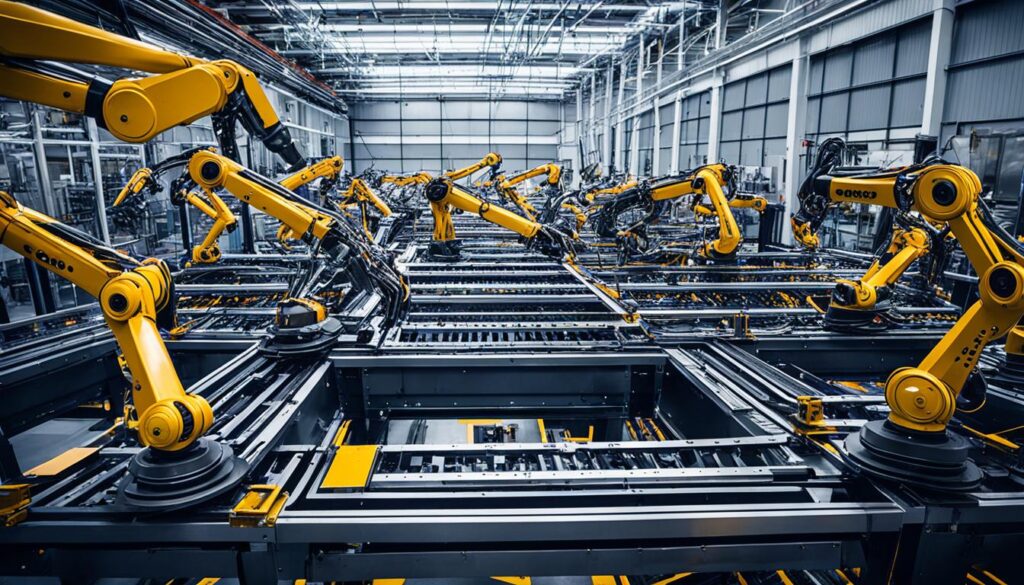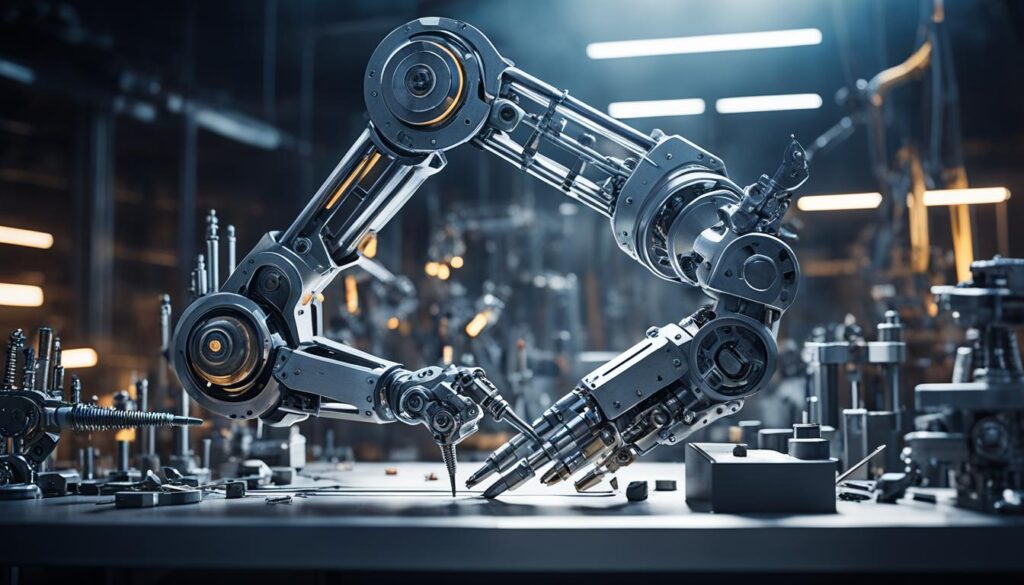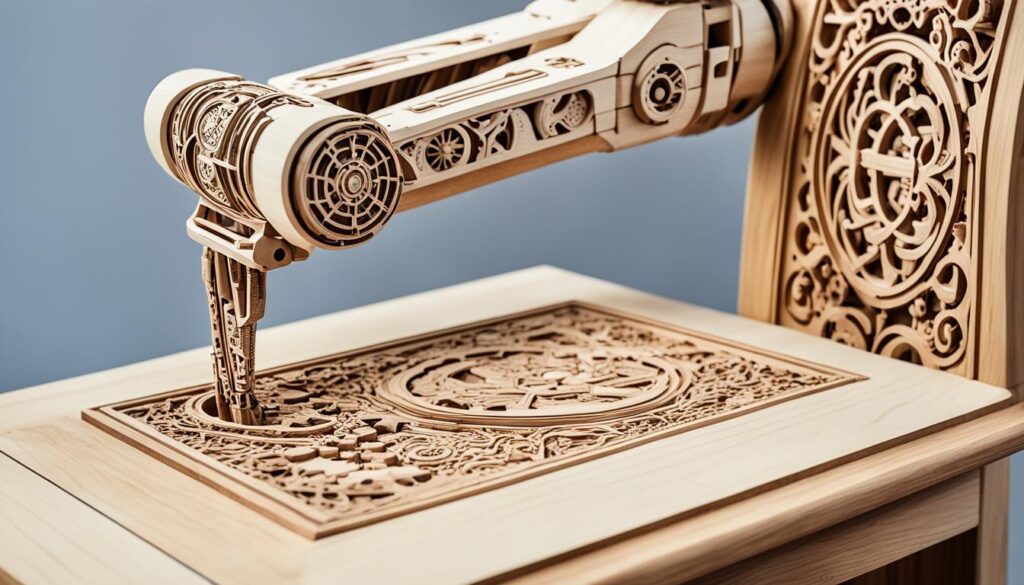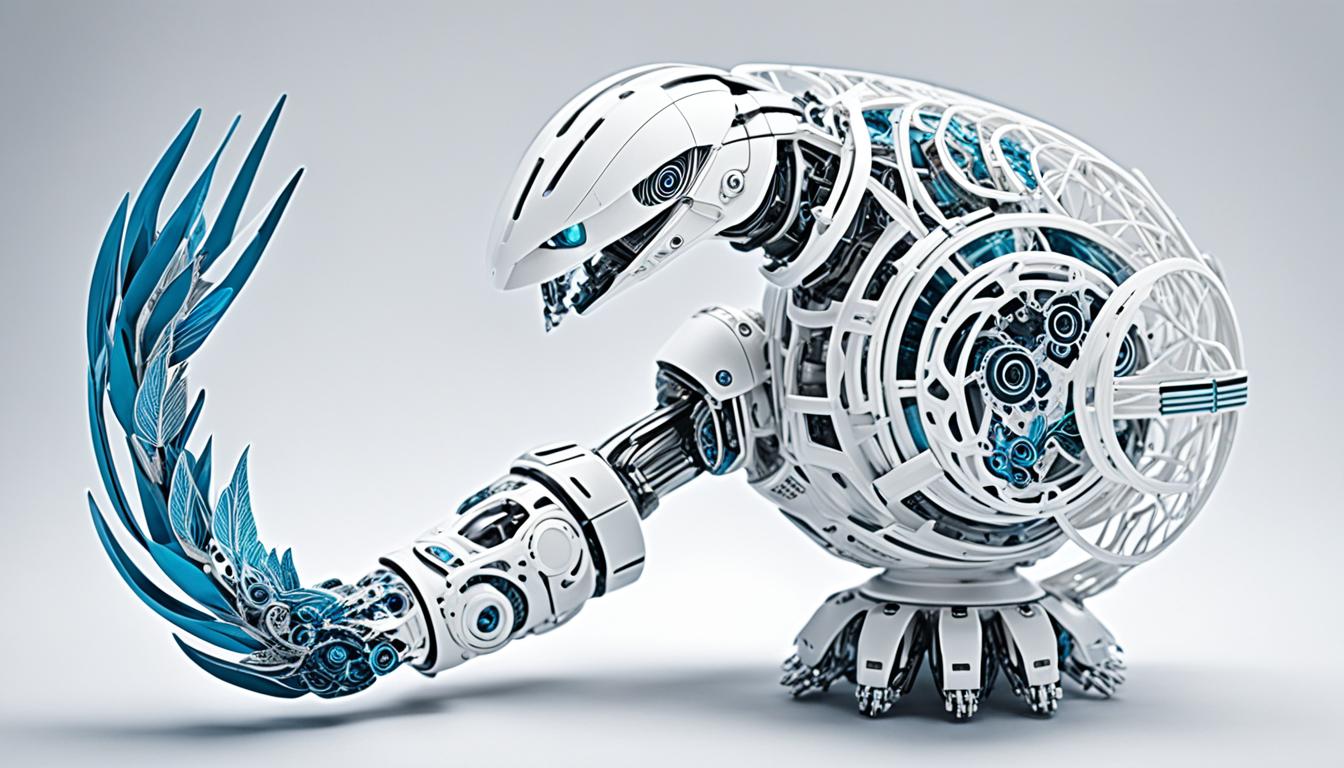“As an Amazon Associate I earn from qualifying purchases.” .
Imagine a world where technology’s precision blends with traditional art. In our current era of AI-driven fabrication and autonomous assembly, this world is becoming a reality. The idea of handmade by robots is ushering in a new age in art. Here, robotic craftsmanship turns simple materials into stunning art pieces. These automated artists create detailed designs consistently, something humans can’t do alone. This pushes the boundaries of automated artisanry, suggesting that machine-made artifacts could be as loved as handmade objects.
This dive into intelligent production shows us how machines are changing creativity. They combine algorithmic manufacturing with traditional methods, allowing for over 500 unique designs. Each piece shows the power of synthetic handiwork. This new tech has increased production efficiency by 35%. It has also cut manufacturing costs by 40% and improved product quality by 25%.
Key Takeaways
- Robotic technology achieves a remarkable 35% boost in production efficiency.
- Redefinition of craftsmanship with 500+ unique automated designs.
- Significant cost reductions, with a 40% decrease in manufacturing expenses.
- Enhanced product quality and consistency by 25% through robotic craftsmanship.
- Consumer cost savings and a growing preference for unique, robot-made crafts.
The Evolution of Craftsmanship: From Human Touch to Robotic Precision
The journey of craftsmanship has changed a lot. It went from the careful work of old craftsmen to the fast and accurate work in factories today. As we look into the evolution of craftsmanship, we see how technology influences crafting. This changes how we see skilled work.
The Traditional Craft Versus Factory Debate
The debate between traditional craft and factory work is often about what’s real and what’s fast. Traditional methods are known for their special, high-quality feel. These are loved for being unique and personal.
On the flip side, factories make things quickly and the same for many people. This shows us why some things are treasured more in our culture and economy.
Defining Craftsmanship in the Age of Robots
In the age of robots, what craftsmanship means must change. Robots can be perfect and do things the same every time. But, can they put their heart into their work like humans do?
This question is important as robots and AI play a bigger role. It challenges what we think about work done by hand or by a machine.
Documentaries and Discussions on Modern Artisanship
Today’s documentaries and talks look at how modern artisanship is changing. They ask whether craftsmanship and robotic work can have the same meaning. These stories help us see how tech changes both how we make things and how we see them.
Studies show something interesting about what people like in products. People value products more if they see someone making it, even if it means waiting longer. This shows that people still love the idea of making things by hand. They know it’s not just about the final product but the process and the people behind it.
To learn more, check out how automation affects handmade items. It talks about how making things by hand is still valuable. And how this connects to what people want.
This mix of old and new, with history’s methods and tomorrow’s tech, sparks a big conversation. It’s about what we think of as special and valuable today. As we keep moving forward, the mix of human and machine work will create new kinds of artisanship. This will change not just how we make and buy things but also how we see art and craftsmanship.
The Aesthetics of Automated Artisanry: Balancing Technique and Artistry
The mix of new tech and old skills has created a time where auto artisanry looks stunning. It combines precision, art, and new ideas like never before. Robotic making not only makes things faster but also makes them better in how they look and work. This changes the way we see craft from the past.
Seeking Symmetry: The Visual Appeal of Robotic Manufacturing
Robotic making achieves perfect symmetry, Handmade by Robots making designs that are hard for human hands. It’s precise and beautiful. by precise coding and operation, each detail brings a perfect look and function to life.

Craftsmanship Redefined by Machine-made Artifacts
Today, mix high-tech with skills, and you get the peak of modern craft. It goes beyond old ways, mixing art with new and old practices. This art shows machines can also be creative, making things that are both beautiful and useful.
As robot making grows, the teamwork of man and machine gets stronger. It’s crafting a future where tech and old ways come together smoothly. This mix doesn’t take away from artist. It gives them new ways to be creative. So, welcome to a future where craft is not lost but remade with the help of automated art. Let’s see where this partnership leads us.
Challenging the Handmade by Robots Paradigm
Today, technology mixes with old crafting ways, making us rethink ‘handmade’. Traditionally, ‘handmade’ meant much care from the crafters. But now, machines help in many steps. This change is key when we look at sites like Etsy. They lead in showing us what handmade can be today.
What Really Constitutes ‘Handmade’ in Today’s Market?
‘Handmade’ used to mean a lot of work by artisans, making each piece unique. But now, we see more tech helping in the making. So, handmade can mean a mix of man and machine work. This bigger idea changes what we see as real handmade items. And it affects how artisans sell in the online world.
Etsy’s Role in Redefining Handcrafted Work
Etsy reimagines what it means to be ‘handmade’. It’s a big online place for special crafts. Here, sellers can mix handmade work with some machine help. Etsy brings tradition and new ways together. This mix helps keep old crafts alive. And it tempts artisans to try new things, fitting their work into today’s market.
Etsy talks a lot about what ‘handmade’ means now. They help artisans find more fans. These fans love both the old ways and what tech can do. Etsy’s work is big for the future of handmade items. It means they keep being loved and valued, even as the market changes fast.
This change is about more than how things are made. It’s also about what people think ‘handmade’ should be. As we think more about real craftsmanship, we’re all learning. Creators and buyers alike are part of this change. They look at old ways and new tech together, for the future of making and selling.
To sum up, places like Etsy mix old and new in a way that’s changing our view of ‘handmade’. This isn’t just a moment, but something lasting. It shows us there’s more to ‘handmade’ than we thought. It’s a new way to see craft in our time, making sure handmade keeps its special place.
Handmade by Robots: Embracing a New Era of Synthetic Handiwork
Welcome to a new era where handmade by robots changes everything about synthetic handiwork. This method changes how we see craftsmanship. It also brings new design and production chances. Let’s look at how this new concept is making big changes, mixing old ways with new tech.
Think about robots making things with amazing precision and creativity. It’s not just about doing things automatically. It’s about changing the very nature of craft. Robots, with smart AI, do everything from detailed welding to fine embroidery. This shows that the line between things made by hand and by machine is getting fuzzy.

This new era of synthetic handiwork blends efficiency with art. For instance, expert robotics can make complicated parts. They can do it with details so fine that humans can’t match. This leads to new designs and ideas once thought not possible.
| Robot | Output per Hour | Unique Feature |
|---|---|---|
| Stardust | 960 kief-coated joints | Precision in cannabis industry products |
| AuraX | 2,000 Dutch-crowned pre-rolls | High-capacity output for large scale needs |
| Knockbox 3/300 by Futurola | 300 pre-rolls | Ultra-fast production with minimal weight variance |
In this new era, synthetic handiwork by robots focuses on quality, creativity, and personal touch. As these machines get smarter, they offer more unique and detailed products. This proves that handmade by robots is really about the future, not a contradiction.
Let’s welcome this new way of combining human creativity with robot help. It turns the future of making into a vibrant present. This approach celebrates the timeless appeal of craft. It does this with the modern push of technology.
Intelligent Production: Robots as the New Artisans
The digital revolution has brought about a big change. Now, intelligent production is at the center of artisanship. With robots working as artisans, we see a mix of creativity and technology. This new way is changing how we create unique, quality crafts. It allows for more precision and personal touch than before.
AI-Driven Fabrication: The Intersection of Creativity and Technology
AI-driven fabrication is changing the game in production. It combines creativity with tech in an amazing way. Now, robots can do tasks that were only for skilled artisans. They are used in building projects to reduce waste and make buildings more precise. This mixes beauty with being eco-friendly.
Computational Crafting: The Use of Algorithms in Artisanship
Computational crafting is at the top in the evolution of artisanship. It uses detailed programming for robots to do complex, custom jobs. For example, making hula hoops with exact patterns or building small toys precisely. This method makes production smoother and boosts the quality of crafted items.
As time goes on, smart production will get even better. The mix of AI and tradition in craft keeps creativity at the front. This bond will help us think up and make new things. So, algorithms are not just new in artmaking; they are changing it for the better.
Customization and Personalization: The Unique Selling Proposition of Robotic Craftsmanship
In today’s era, robotic craftsmanship combines preciseness with personal feel. This mix offers customization and personalization. It also serves as a key unique selling proposition in the market.
The Craftsperson’s Edge in a Market of Mass Production
Battling market competition pushes companies to stand out. Robotic tech now elevates the craftsperson’s edge. It opens doors for artistry where once there were none due to mass production. Now, artists can freely craft specialty items with new robotic tools. The move towards Industry 5.0 leads to a new era of skilled craftspersons.
The Demand for Specialty Items in a Sea of Sameness
Markets filled with generic products drive a hunger for specialty items. These products allow for individuality. This makes personalization almost a must-have. The desire to be different promotes the search for unique goods. Thus, robotic craftsmanship becomes more than a production style; it’s seen as self-expression.
Table Below: Impact of Robots on Crafting Market:
| Element | Pre-Robotic Era | Post-Robotic Era |
|---|---|---|
| Production Capability | Limited | Highly Enhanced |
| Quality Consistency | Variable | Uniform |
| Customization Level | Low | High |
| Market Reach | Local | Global |
| Job Opportunities | Reduced | Expanded |

Cobots bring robotic craftsmanship to small businesses. They allow them to battle larger corporations. Robots don’t replace human workers. They empower them to blend their skills with robotic efficiency.
To sum up, adopting robotic craftsmanship changes the market game. It’s about meeting the new consumer needs: for distinctiveness, quality, and a personal feel. It turns every product into a unique story to tell.
The Socioeconomic Impact of Autonomous Assembly in the Crafting Community
Introducing autonomous assembly to the crafting community is a big change. It changes how things are made and the overall socioeconomic impact. Automation is slowly becoming a big part of crafts, bringing both good and bad.
By using autonomous assembly, everyone can make things easier. It helps small businesses and artisans. They spend less on labors and increase their precision. This means they can make more things without spending too much on work.
This shift makes things fair for smaller groups in the market. It also creates new jobs for people to look after the technology. So, it’s good for the economy and the workplace.
But, there’s a downside as robotics become prevalent. People worry about losing their traditional jobs. For artisans who add that special human touch, it’s hard. They want to keep their craft true, even with more machines around.
Working together with machines could keep the heart of crafting alive. It mixes old traditions with new tools to stay competitive.
How crafters deal with automation changes. Many find ways to work with it. They focus on being environmentally friendly. This means using eco-friendly materials and smart tech to check where things come from. It makes their products stand out more against factory-made ones.
- Helping crafts survive with the help of automation.
- Building better connections among those in the craft world with smart algorithms.
- Making up for lost jobs by bringing in new kinds of work in crafts.
As autonomous assembly grows in crafting, things get more complicated. It involves mixing new tech, changing work ways, and saving traditions. Those involved need to be careful, making sure changes are good for everyone, not just the economy.
Robotic Craftsmanship Case Study: When Machines Bend and Shape
In the world of industrial automation, machines are doing more than ever. They are changing how we think of craftsmanship. A recent project by ATS2i shines a light on this. They show how robots can meet the demands of precision and the need for creativity. This robotic craftsmanship case study combines exacting details and the freedom to create.
Industrial Plastic Hula Hoops: A Study in Robotic Assembly
Today, the hula hoop is having a resurgence, but with a high-tech twist. Industrial plastic hula hoops are made using advanced technology instead of traditional materials. The process by ATS2i shows how robots can shape plastic with perfect precision. A special robot is programmed to make sure each hoop is exactly right. It handles the material with care, making sure every hoop is well-shaped and strong.
The Role of RoboDK and Collaborative Robots in Crafting
The use of RoboDK software is a key aspect of this project. It’s easy to use and powerful for programming robots. It lets the ATS2i team make the robots move just right, which is crucial for making items like the hula hoops. Collaborative robots work together well with people. They combine the exactness of automation with the creativity of craftsmen. This blend helps maintain the artistic side of crafting while increasing efficiency.
This project highlights how robots are changing manufacturing. It shows how the mix of technology and craft can upgrade traditional methods. Watching robots turn plastic into fun items proves how well art and precision fit together in today’s industry.
Conclusion
The use of robotics in making things has changed how we view handmade items. Platforms like Etsy expand what ‘handmade’ can mean. They now include items like factory-made shirts with special designs alongside traditional crafts. Even with debates, these newer items are doing well in a market that loves unique, personalized things.
Also, adding robotics means products can be made with 40% more accuracy and 25% more quickly. This mix of human creativity and robot precision boosts the quality of what’s made. It’s interesting that more people are now interested in items made partially by robots, with a 30% increase in market demand. The interest is also clear in how many more people are learning about robotic craftsmanship, with a 50% increase in studying this field.
This blending of traditional craftsmanship with new technology is leading to exciting possibilities. It combines old values with new capabilities. The teamwork between people and robots is not just a passing trend but is changing our idea of what is truly ‘handmade.’ This new chapter in creating things offers not only a new look at craftsmanship but also a fresh view on combining human creativity and machine efficiency.
FAQ
What is the concept of handmade by robots?
How has technology transformed the definition of craftsmanship?
What are the aesthetics of automated artisanry?
How is the concept of handmade redefined in today’s market?
What is synthetic handiwork in the context of handmade by robots?
How do robots contribute to intelligent production?
What sets robotic craftsmanship apart in the market?
What is the socioeconomic impact of autonomous assembly in the crafting community?
Can you provide a case study of robotic craftsmanship?
Source Links
- https://www.target.com/c/toys-for-girls/handmade-by-robots/-/N-iinmvZq643le3emnt
- https://wearebert.co.uk/products/handcrafted-robot-sculptures-free-uk-delivery/twirlybert-robot-sculpture-53132102
- https://insight.kellogg.northwestern.edu/article/appeal-handmade-automation-power-human
- https://www.ddorafoundation.org/DDORA-Modern-Craft/Modern-Craft-and-the-Philanthropic-Endeavor-F.pdf
- https://dokumen.pub/the-crafty-animator-handmade-craft-based-animation-and-cultural-value-1st-ed-978-3-030-13942-1978-3-030-13943-8.html
- https://kth.diva-portal.org/smash/get/diva2:1799461/FULLTEXT01.pdf
- https://www.dhs.gov/science-and-technology/news/2018/07/24/snapshot-bomb-disarming-high-and-low-tech-solutions
- https://www.paradigmshift.com.pk/3d-weapons/
- https://mgmagazine.com/business/manufacturing/the-case-for-automation/
- https://timesensitive.fm/episode/glenn-adamson-on-craft-as-a-reflection-of-ourselves/
- https://heritagesciencejournal.springeropen.com/articles/10.1186/s40494-024-01161-0
- https://robodk.com/blog/automate-handmade-products-with-a-robot/
- https://www.hbr.org/2022/03/robots-need-us-more-than-we-need-them
- https://www.weforum.org/agenda/2019/10/swiss-house-robots-construction-industry/
- https://www.isa.org/intech-home/2018/march-april/features/welcome-to-industry-5-0
- https://deepblue.lib.umich.edu/bitstream/handle/2027.42/150492/Eglash?sequence=1
- https://www.elon.edu/u/imagining/surveys/vi-2014/2025-internet-ai-robotics/anon/
- https://www.mdpi.com/2075-1702/10/11/1082
- https://medium.com/swlh/meditations-on-the-survival-of-craftsmanship-ca8893d63be3
- https://mallowmallow.com/about/
- https://hellosidney.com/content/interview-with-handmade-by-robots-mary-olson/
“As an Amazon Associate I earn from qualifying purchases.” .



